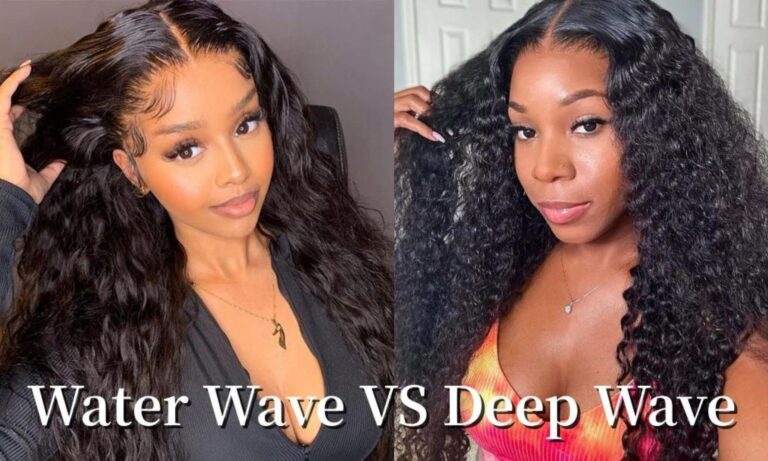In the world of hair styling, waves have become a popular choice for adding texture and volume. Two of the most sought-after wave styles are water waves and deep waves. Both offer distinct looks and can dramatically change the appearance of your hair. This article delves into the key differences betweenWater Wave vs. Deep Wave, helping you choose the perfect style for your needs.
When it comes to hair waves, the terms “water wave” and “deep wave” often come up. These styles not only differ in their visual impact but also in how they are achieved and maintained. Understanding these differences can help you make an informed decision about which wave style suits you best. In this comprehensive guide, we will explore the characteristics, benefits, and maintenance of water waves and deep waves.
What Are Water Waves?
Definition
Water waves are characterized by their soft, flowing, and natural-looking curls. They mimic the gentle ripples seen on the surface of water, hence the name. This style is ideal for those looking for a relaxed and beachy look.
How to Achieve Water Waves
Achieving water waves involves using styling tools or techniques that create loose, S-shaped curls. Here are some popular methods:
Curling Wands: Use a large-barrel curling wand to create soft waves. Wrap sections of hair around the wand, hold for a few seconds, and release.
Flat Irons: A flat iron can also be used to create water waves by clamping down on sections of hair and twisting as you slide down.
Braiding: For a heat-free method, braid damp hair and let it dry. Once unbraided, you’ll have soft, natural waves.
Benefits of Water Waves
Natural Look: Water waves provide a subtle, natural look that is perfect for everyday wear.
Versatility: This style can be dressed up or down, making it suitable for various occasions.
Low Maintenance: Once styled, water waves require minimal upkeep.
Maintaining Water Waves
To keep your water waves looking fresh, use a light-hold hairspray and avoid excessive brushing. Sleeping on a silk pillowcase can help preserve the waves and reduce frizz.
What Are Deep Waves?
Definition
Deep waves feature more pronounced, dramatic curls compared to water waves. These waves are tighter and more defined, creating a bolder look with significant volume and texture.
How to Achieve Deep Waves
Deep waves are typically created using tools or techniques that produce more structured curls. Methods include:
Deep Wave Curling Irons: Specialized curling irons with deep wave plates can create this look in a single pass.
Perming: A more permanent solution, perming can achieve deep waves that last for several months.
Waving Tools: Some tools are specifically designed to create deep, uniform waves.
Benefits of Deep Waves
Volume and Texture: Deep waves add considerable volume and texture, making hair appear fuller.
Long-Lasting: The style tends to last longer compared to softer waves, especially when achieved with perming.
Dramatic Look: Ideal for those who want a more dramatic and eye-catching style.
Maintaining Deep Waves
To maintain deep waves, use a moisturizing shampoo and conditioner to keep hair hydrated. Avoid brushing the waves too frequently and use a wide-tooth comb to detangle.
Water Wave vs. Deep Wave: A Comparative Analysis
Visual Impact
Water Waves: Offer a softer, more relaxed appearance with gentle, flowing curls.
Deep Waves: Provide a bold and voluminous look with tight, well-defined curls.
Styling Time
Water Waves: Generally quicker to style, especially with tools like curling wands.
Deep Waves: May require more time and effort, particularly if using a deep wave curling iron or opting for a perm.
Longevity
Water Waves: Tend to be less permanent and may require daily touch-ups.
Deep Waves: Typically more enduring, especially with chemical treatments like perming.
Maintenance
Water Waves: Easier to maintain with minimal upkeep needed.
Deep Waves: Require more maintenance to keep the curls looking fresh and voluminous.
Conclusion
Choosing between Water Wave vs. Deep Wave depends on your personal style, desired look, and maintenance preferences. Water waves offer a relaxed, natural appearance suitable for everyday wear, while deep waves provide a dramatic and voluminous look that stands out. Both styles have their own set of benefits and require different methods of styling and maintenance.
By understanding these differences, you can select the wave style that best fits your needs and lifestyle. Whether you prefer the soft, flowing texture of water waves or the bold, defined curls of deep waves, both can enhance your overall look and make a statement.
FAQs
Can I achieve water waves without heat?
Yes, water waves can be achieved without heat by braiding damp hair and allowing it to dry. This method is gentle on the hair and produces natural-looking waves.
How long do deep waves last?
Deep waves can last several days to weeks, depending on how they are achieved. Permanent methods like perming offer longer-lasting results compared to temporary styling tools.
Are water waves suitable for all hair types?
Water waves are versatile and can be adapted to various hair types, including straight, wavy, and curly hair. They work well on medium to long hair lengths.
How can I reduce frizz with deep waves?
To reduce frizz, use a smoothing serum or leave-in conditioner. Avoid excessive heat styling and protect your hair from humidity to maintain smooth, defined waves.
Can deep waves be achieved with a curling wand?
Yes, deep waves can be created using a curling wand with a deep wave barrel. This tool helps achieve the tight, defined curls characteristic of deep waves.

